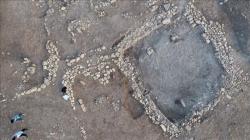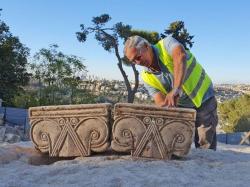INSTITUT SUPERIEUR D'ANTHROPOLOGIE
INSTITUTE OF ANTHROPOLOGY
ONLINE COURSES / COURS A DISTANCE
AUTUMN TERM : OCTOBER 2020
REGISTER NOW
TURQUIE –  Kizilkoyun - Archaeologists began excavations in an area where 2,000-year-old rock tombs were unearthed and bear resemblance to the discoveries in the ancient site of Gobeklitepe, known as the world's oldest temple. Sanliurfa Metropolitan Municipality carries out the excavations in the Kizilkoyun Necropolis area, where 2,000-year-old rock tombs were discovered. The excavation, which started near the area where the statue of Balikligol dating to 9500 B.C. is located, created excitement that new discoveries may also be made. The statue -- also known as Urfa Man, 1.80 meters tall and dubbed the “oldest naturalistic life-sized sculpture of a human” -- attracts attention with its similarity to the discoveries in Gobeklitepe. New artifacts are expected to be found to solve the mystery of Gobeklitepe in the excavations that started in the area where some mosaics depicting hunting Amazon queens were found earlier. “Kizilkoyun, one of the most important necropolises of Edessa city, is very rich in terms of tomb sizes and decorations.
Kizilkoyun - Archaeologists began excavations in an area where 2,000-year-old rock tombs were unearthed and bear resemblance to the discoveries in the ancient site of Gobeklitepe, known as the world's oldest temple. Sanliurfa Metropolitan Municipality carries out the excavations in the Kizilkoyun Necropolis area, where 2,000-year-old rock tombs were discovered. The excavation, which started near the area where the statue of Balikligol dating to 9500 B.C. is located, created excitement that new discoveries may also be made. The statue -- also known as Urfa Man, 1.80 meters tall and dubbed the “oldest naturalistic life-sized sculpture of a human” -- attracts attention with its similarity to the discoveries in Gobeklitepe. New artifacts are expected to be found to solve the mystery of Gobeklitepe in the excavations that started in the area where some mosaics depicting hunting Amazon queens were found earlier. “Kizilkoyun, one of the most important necropolises of Edessa city, is very rich in terms of tomb sizes and decorations.
https://www.aa.com.tr/en/turkey/excavations-in-rock-tombs-to-bare-gobeklitepe-s-mystery/1964138
ROYAUME UNI –  Holyrood Park - Archaeologists working at the top of Arthur's Seat in Holyrood Park have uncovered the walls of an prehistoric hill fort first inhabited by a mysterious and ancient Scots people. The hilltop defences are believed to have been constructed by the Votadini, an ancient people who ruled South East Scotland during the Iron Age, almost 3,000 years ago. The Votadini were a powerful people and constructed several impressive settlements in the area, including Traprain Law in East Lothian, which is believed to have been their capital at one point. Previous studies of the Arthur's Seat site found massive stone walls at least 5.4m in thickness by up to 1.2m in height, blocking off access on one side while steep cliffs provided protection on the others. There was also evidence of farming as part of the settlement.
Holyrood Park - Archaeologists working at the top of Arthur's Seat in Holyrood Park have uncovered the walls of an prehistoric hill fort first inhabited by a mysterious and ancient Scots people. The hilltop defences are believed to have been constructed by the Votadini, an ancient people who ruled South East Scotland during the Iron Age, almost 3,000 years ago. The Votadini were a powerful people and constructed several impressive settlements in the area, including Traprain Law in East Lothian, which is believed to have been their capital at one point. Previous studies of the Arthur's Seat site found massive stone walls at least 5.4m in thickness by up to 1.2m in height, blocking off access on one side while steep cliffs provided protection on the others. There was also evidence of farming as part of the settlement.
https://www.edinburghlive.co.uk/news/edinburgh-news/archaeologists-unearth-ancient-fort-built-18878778
COREE –  Gyeongju - A full set of accessories have been unearthed, which are presumed to belong to a women of the highest status during the Silla Dynasty in the first half of the sixth century. This is the first case where the dead of the tomb has been found wearing accessories from head to toe. The Cultural Heritage Administration announced Thursday that a precision excavation into the ancient tomb No. 120-2 of Hwangnam-dong, Gyeongju City, has found a number of jewelry items including a gilt-bronze crown, gold earrings, silver bracelets, a silver belt, and gilt-bronze shoes. The gilt-bronze crown has a round frame (that fits into the head) at the bottom, with three pieces of twigs-shaped ornaments and two pieces of deer-horn ornaments attached on the top. The crown was fold flat and discovered covering the face of the dead, instead of the head. Experts say that this rare case of excavation is intended to cover up the face of the dead as courtesy. Silver rings have been found as well, five from the right hand and one from the left. “The left hand has not been exposed entirely, so more rings could show up,” explained an official from the administration. “It is possible that the dead might be wearing rings in every finger, just like the buried of the ancient tomb of Cheonmachong.” “There have been some excavation cases where the buried was found wearing a gold-bronze crown in the head, but there was never a body fully clad with jewelry like this,” said Lee Han-sang, a professor of archaeology at Daejeon University. “This is a very important piece of evidence explaining how the dead were dressed during the Silla era.”
Gyeongju - A full set of accessories have been unearthed, which are presumed to belong to a women of the highest status during the Silla Dynasty in the first half of the sixth century. This is the first case where the dead of the tomb has been found wearing accessories from head to toe. The Cultural Heritage Administration announced Thursday that a precision excavation into the ancient tomb No. 120-2 of Hwangnam-dong, Gyeongju City, has found a number of jewelry items including a gilt-bronze crown, gold earrings, silver bracelets, a silver belt, and gilt-bronze shoes. The gilt-bronze crown has a round frame (that fits into the head) at the bottom, with three pieces of twigs-shaped ornaments and two pieces of deer-horn ornaments attached on the top. The crown was fold flat and discovered covering the face of the dead, instead of the head. Experts say that this rare case of excavation is intended to cover up the face of the dead as courtesy. Silver rings have been found as well, five from the right hand and one from the left. “The left hand has not been exposed entirely, so more rings could show up,” explained an official from the administration. “It is possible that the dead might be wearing rings in every finger, just like the buried of the ancient tomb of Cheonmachong.” “There have been some excavation cases where the buried was found wearing a gold-bronze crown in the head, but there was never a body fully clad with jewelry like this,” said Lee Han-sang, a professor of archaeology at Daejeon University. “This is a very important piece of evidence explaining how the dead were dressed during the Silla era.”
https://www.donga.com/en/List/article/all/20200904/2170724/1/A-body-fully-dressed-with-jewelry-excavated-in-Gyeongju
ETATS UNIS –  Etzanoa - A Dartmouth-led study using multisensor drones has revealed a large circular earthwork at what may be Etzanoa, an archaeological site near Wichita, Kansas. Archaeologists speculate that the site was visited by a Spanish expedition, led by Juan de Oñate, a controversial conquistador, in 1601. The earthwork may be the remains of a so-called "council circle," as it is similar to several other circular earthworks in the region, according to the study's findings published in American Antiquity. Topographically, the area is flat with no visible archaeological features. Yet, imagery shows that underground there is an ancient, circular shaped ditch measuring 50 meters wide and approximately 2 meters thick that has been infilled.
Etzanoa - A Dartmouth-led study using multisensor drones has revealed a large circular earthwork at what may be Etzanoa, an archaeological site near Wichita, Kansas. Archaeologists speculate that the site was visited by a Spanish expedition, led by Juan de Oñate, a controversial conquistador, in 1601. The earthwork may be the remains of a so-called "council circle," as it is similar to several other circular earthworks in the region, according to the study's findings published in American Antiquity. Topographically, the area is flat with no visible archaeological features. Yet, imagery shows that underground there is an ancient, circular shaped ditch measuring 50 meters wide and approximately 2 meters thick that has been infilled.
https://www.eurekalert.org/pub_releases/2020-09/dc-dsr090320.php
ROYAUME UNI – Lincoln - Archaeologists will be excavating an Anglo-Saxon burial site in a village near Lincoln this week. They'll be at the site in Cammeringham from Tuesday, September 1, to Friday, September The site was discovered by metal detectorists in September 2019, who found a series of weapons, jewellery and dress accessories. Lisa Brundle said: "This is really exciting. It is such an important and significant site for our Lincolnshire heritage. "We've seen amazing jewellery, brooches and weapons found here previously, including a brooch showing a mysterious moustached man – he is thought to have provided the wearer with luck.
https://www.lincolnshirelive.co.uk/news/local-news/archaeologists-excavate-anglo-saxon-cemetery-4474790
ISRAEL –  Jerusalem - A grand palace dating back to the time of the Kings of Judah has been discovered by archaeologists in Jerusalem. The site sits on the Armon Hanatziv Promenade and may have been the home of one of the Kings of Judah or a high-ranking family "of nobility and wealth" from the First Temple period. Among the finds are magnificent column capitals described by the Israel Antiquities Authority (IAA) as "the most beautiful and impressive that have been uncovered to date". The structure would have been "monumental", with "breathtaking" views of Jerusalem and the Temple. The IAA said the discovery testified to an "exit from the walls" in First Temple period Jerusalem, suggesting a "period of renewed security felt sometime after the Assyrian siege of Jerusalem ended". Unusually, the capitals were found neatly buried one on top of the other, and in excellent condition. By contrast, the rest of the building was destroyed, probably in the Babylonian destruction of Jerusalem in around 586 BC. The palace was built in the period between the days of King Hezekiah and King Josiah, and point to the restoration of Jerusalem after the devastating Assyrian siege of the city in 701 BC - during the reign of King Hezekiah.
Jerusalem - A grand palace dating back to the time of the Kings of Judah has been discovered by archaeologists in Jerusalem. The site sits on the Armon Hanatziv Promenade and may have been the home of one of the Kings of Judah or a high-ranking family "of nobility and wealth" from the First Temple period. Among the finds are magnificent column capitals described by the Israel Antiquities Authority (IAA) as "the most beautiful and impressive that have been uncovered to date". The structure would have been "monumental", with "breathtaking" views of Jerusalem and the Temple. The IAA said the discovery testified to an "exit from the walls" in First Temple period Jerusalem, suggesting a "period of renewed security felt sometime after the Assyrian siege of Jerusalem ended". Unusually, the capitals were found neatly buried one on top of the other, and in excellent condition. By contrast, the rest of the building was destroyed, probably in the Babylonian destruction of Jerusalem in around 586 BC. The palace was built in the period between the days of King Hezekiah and King Josiah, and point to the restoration of Jerusalem after the devastating Assyrian siege of the city in 701 BC - during the reign of King Hezekiah.
https://www.christiantoday.com/article/archaeologists.uncover.magnificent.palace.from.the.time.of.the.kings.of.judah/135482.htm